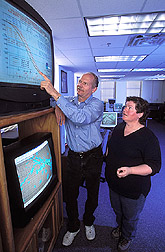This page has been archived and is being provided for reference purposes only. The page is no longer being updated, and therefore, links on the page may be invalid.
Read the magazine story to find out more. |
|
|
Making NOAA Climate Forecasts Useful to Farmers
By Don ComisNovember 6, 2009
Climate forecasts are becoming more useful to farmers and ranchers, thanks to research by Agricultural Research Service (ARS) scientists and their cooperators.
Meteorologist Jeanne Schneider, hydraulic engineer Jurgen Garbrecht and hydrologist John Zhang at the ARS Great Plains Agroclimate and Natural Resources Research Unit in El Reno, Okla., are working with the National Oceanic and Atmospheric Administration (NOAA) to translate seasonal climate forecasts into possible daily weather outcomes. This research supports the U.S. Department of Agriculture’s priority of helping farmers and ranchers cope with climate change.
Currently, NOAA forecasts are seldom used in agriculture. One problem is that they cover too large an area for direct agricultural application.
Schneider found that NOAA’s predictions of periods of above-average temperatures were accurate enough to be possibly useful for agriculture over most of the lower 48 states. However, currently available forecasts for cooler-than-average temperatures are generally too unreliable for many uses anywhere in the country.
Forecasts for wetter- or drier-than-average conditions are mostly useful in only about 10 percent of the lower 48 states. In these regions, seasonal precipitation predictions may assist crop insurance programs and other agricultural enterprises that operate at regional scales.
Garbrecht, Schneider and Zhang are developing computer models for climate-related decision support. Schneider developed new methods to downscale seasonal forecasts to the farm scale and express them in one-month increments. Garbrecht modified an ARS-developed software program to generate daily weather outcomes corresponding to these monthly climate forecasts. And Zhang developed a winter wheat grazing model to assess potential impacts of the seasonal forecasts on forage, beef and grain production.
Forecast methodologies are improving rapidly, spurring major advances in NOAA forecasting.
Demonstrations of specific agricultural applications in regions that can currently benefit from forecasts should help spur wider use elsewhere as forecasts improve.
Read more about this and other climate change research in the November-December 2009 issue of Agricultural Research magazine.
ARS is USDA’s principal intramural scientific research agency.

